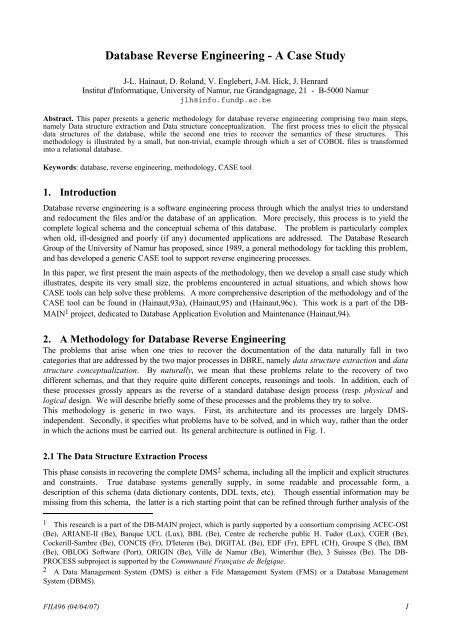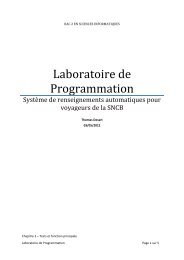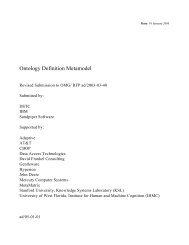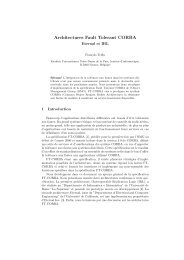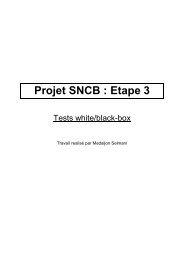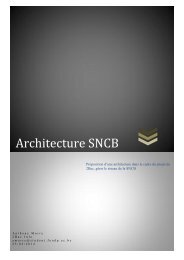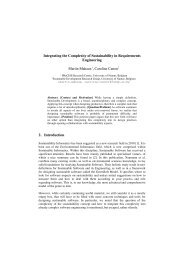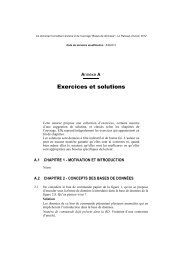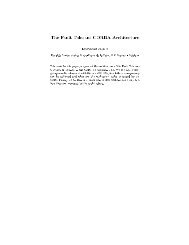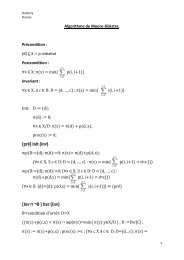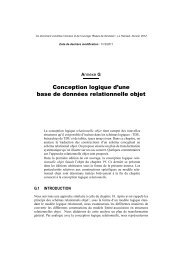Database Reverse Engineering - A Case Study - Institut d'Informatique
Database Reverse Engineering - A Case Study - Institut d'Informatique
Database Reverse Engineering - A Case Study - Institut d'Informatique
You also want an ePaper? Increase the reach of your titles
YUMPU automatically turns print PDFs into web optimized ePapers that Google loves.
<strong>Database</strong> <strong>Reverse</strong> <strong>Engineering</strong> - A <strong>Case</strong> <strong>Study</strong><br />
J-L. Hainaut, D. Roland, V. Englebert, J-M. Hick, J. Henrard<br />
<strong>Institut</strong> <strong>d'Informatique</strong>, University of Namur, rue Grandgagnage, 21 - B-5000 Namur<br />
jlh@info.fundp.ac.be<br />
Abstract. This paper presents a generic methodology for database reverse engineering comprising two main steps,<br />
namely Data structure extraction and Data structure conceptualization. The first process tries to elicit the physical<br />
data structures of the database, while the second one tries to recover the semantics of these structures. This<br />
methodology is illustrated by a small, but non-trivial, example through which a set of COBOL files is transformed<br />
into a relational database.<br />
Keywords: database, reverse engineering, methodology, CASE tool<br />
1. Introduction<br />
<strong>Database</strong> reverse engineering is a software engineering process through which the analyst tries to understand<br />
and redocument the files and/or the database of an application. More precisely, this process is to yield the<br />
complete logical schema and the conceptual schema of this database. The problem is particularly complex<br />
when old, ill-designed and poorly (if any) documented applications are addressed. The <strong>Database</strong> Research<br />
Group of the University of Namur has proposed, since 1989, a general methodology for tackling this problem,<br />
and has developed a generic CASE tool to support reverse engineering processes.<br />
In this paper, we first present the main aspects of the methodology, then we develop a small case study which<br />
illustrates, despite its very small size, the problems encountered in actual situations, and which shows how<br />
CASE tools can help solve these problems. A more comprehensive description of the methodology and of the<br />
CASE tool can be found in (Hainaut,93a), (Hainaut,95) and (Hainaut,96c). This work is a part of the DB-<br />
MAIN 1 project, dedicated to <strong>Database</strong> Application Evolution and Maintenance (Hainaut,94).<br />
2. A Methodology for <strong>Database</strong> <strong>Reverse</strong> <strong>Engineering</strong><br />
The problems that arise when one tries to recover the documentation of the data naturally fall in two<br />
categories that are addressed by the two major processes in DBRE, namely data structure extraction and data<br />
structure conceptualization. By naturally, we mean that these problems relate to the recovery of two<br />
different schemas, and that they require quite different concepts, reasonings and tools. In addition, each of<br />
these processes grossly appears as the reverse of a standard database design process (resp. physical and<br />
logical design. We will describe briefly some of these processes and the problems they try to solve.<br />
This methodology is generic in two ways. First, its architecture and its processes are largely DMSindependent.<br />
Secondly, it specifies what problems have to be solved, and in which way, rather than the order<br />
in which the actions must be carried out. Its general architecture is outlined in Fig. 1.<br />
2.1 The Data Structure Extraction Process<br />
This phase consists in recovering the complete DMS 2 schema, including all the implicit and explicit structures<br />
and constraints. True database systems generally supply, in some readable and processable form, a<br />
description of this schema (data dictionary contents, DDL texts, etc). Though essential information may be<br />
missing from this schema, the latter is a rich starting point that can be refined through further analysis of the<br />
1 This research is a part of the DB-MAIN project, which is partly supported by a consortium comprising ACEC-OSI<br />
(Be), ARIANE-II (Be), Banque UCL (Lux), BBL (Be), Centre de recherche public H. Tudor (Lux), CGER (Be),<br />
Cockerill-Sambre (Be), CONCIS (Fr), D'Ieteren (Be), DIGITAL (Be), EDF (Fr), EPFL (CH), Groupe S (Be), IBM<br />
(Be), OBLOG Software (Port), ORIGIN (Be), Ville de Namur (Be), Winterthur (Be), 3 Suisses (Be). The DB-<br />
PROCESS subproject is supported by the Communauté Française de Belgique.<br />
2 A Data Management System (DMS) is either a File Management System (FMS) or a <strong>Database</strong> Management<br />
System (DBMS).<br />
FIIA96 (04/04/07) 1
other components of the application (views, subschemas, screen and report layouts, procedures, fragments of<br />
documentation, database content, program execution, etc).<br />
The problem is much more complex for standard files, for which no computerized description of their structure<br />
exists in most cases. The analysis of each source program provides a partial view of the file and record<br />
structures only. For most real-world applications, this analysis must go well beyond the mere detection of the<br />
record structures declared in the programs, as will be shown in the case study.<br />
Normalized<br />
conceptual schema<br />
DMS-compliant<br />
optimized schema<br />
CONCEPTUAL<br />
NORMALIZATION<br />
Raw conceptual<br />
schema<br />
SCHEMA<br />
DE-OPTIMIZATION<br />
Conceptual-logical<br />
-physical schema<br />
SCHEMA<br />
UNTRANSLATION<br />
SCHEMA<br />
PREPARATION<br />
SCHEMA<br />
INTEGRATION<br />
DATA<br />
ANALYSIS<br />
PROGRAM<br />
ANALYSIS<br />
DMS-DDL text<br />
ANALYSIS<br />
DMS-DDL<br />
schema<br />
Physical<br />
schema<br />
Programs<br />
Data<br />
DMS-compliant<br />
optimized schema<br />
Figure 1. Main components of the generic DBRE methodology. Quite naturally, this reverse methodology is to be<br />
read from right to left, and bottom-up.<br />
In our generic methodology, the main processes of DATA STRUCTURE EXTRACTION are the following :<br />
• DMS-DDL text ANALYSIS. This rather straighforward process consists in analyzing the data structures<br />
declaration statements (in the specific DDL) included in the schema scripts and application programs. It<br />
produces a first-cut logical schema.<br />
• PROGRAM ANALYSIS. This process is much more complex. It consists in analyzing the other parts of<br />
the application programs, a.o. the procedural sections, in order to detect evidence of additional data<br />
structures and integrity constraints. The first-cut schema can therefore be refined through the detection of<br />
hidden, non declarative structures.<br />
• DATA ANALYSIS. This refinement process examines the contents of the files and databases in order (1)<br />
to detect data structures and properties (e.g. to find the unique fields or the functional dependencies in a<br />
file), and (2) to test hypotheses (e.g. "could this field be a foreign key to this file ?"). Hidden, non<br />
declarative and lost structures can be found in this way.<br />
• SCHEMA INTEGRATION. When more than one information source has been processed, the analyst is<br />
provided with several, generally different, extracted (and possibly refined) schemas. Let us mention some<br />
common situations : base tables and views (RDBMS), DBD and PSB (IMS), schema and subschemas<br />
FIIA96 (04/04/07) 2
(CODASYL), file structures from all the application programs (standard files), etc. The final logical<br />
schema must include the specifications of all these partial views, through a schema integration process.<br />
The end product of this phase is the complete logical schema. This schema is expressed according to the<br />
specific model of the DMS, and still includes possible optimized constructs, hence its name : the DMScompliant<br />
optimized schema, or DMS schema for short.<br />
2.2 The Data Structure Conceptualization Process<br />
This second phase addresses the conceptual interpretation of the DMS schema. It consists for instance in<br />
detecting and transforming or discarding non-conceptual structures, redundancies, technical optimization and<br />
DMS-dependent constructs. It consists of two sub-processes, namely Basic conceptualization and<br />
Conceptual normalization.<br />
• BASIC CONCEPTUALIZATION. The main objective of this process is to extract all the relevant<br />
semantic concepts underlying the logical schema. Two different problems, requiring different reasonings<br />
and methods, have to be solved : schema untranslation and schema de-optimization. However, before<br />
tackling these problems, we often have to prepare the schema by cleaning it.<br />
SCHEMA PREPARATION. The schema still includes some constructs, such as files and access keys,<br />
which may have been useful in the Data Structure Extraction phase, but which can now be discarded. In<br />
addition, translating names to make them more meaningful (e.g. substitute the file name for the record<br />
name), and restructuring some parts of the schema can prove useful before trying to interpret them.<br />
SCHEMA UNTRANSLATION. The logical schema is the technical translation of conceptual constructs.<br />
Through this process, the analyst identifies the traces of such translations, and replaces them by their<br />
original conceptual construct. Though each data model can be assigned its own set of translating (and<br />
therefore of untranslating) rules, two facts are worth mentioning. First, the data models can share an<br />
important subset of translating rules (e.g. COBOL files and SQL structures). Secondly, translation rules<br />
considered as specific to a data model are often used in other data models (e.g. foreign keys in IMS and<br />
CODASYL databases). Hence the importance of generic approaches and tools.<br />
SCHEMA DE-OPTIMIZATION. The logical schema is searched for traces of constructs designed for<br />
optimization purposes. Three main families of optimization techniques should be considered :<br />
denormalization, structural redundancy and restructuring.<br />
• CONCEPTUAL NORMALIZATION. This process restructures the basic conceptual schema in order to<br />
give it the desired qualities one expects from any final conceptual schema, e.g. expressiveness, simplicity,<br />
minimality, readability, genericity, extensibility. For instance, some entity types are replaced by<br />
relationship types or by attributes, is-a relations are made explicit, names are standardized, etc.<br />
3. A small case study<br />
This section is dedicated to a typical application of database reverse engineering, namely database<br />
conversion. The source application is a small COBOL program which uses three files. The objective of the<br />
exercise is to produce a relational schema which translates the semantics of these source files. This can be<br />
done in two steps : first we elaborate a possible conceptual schema of the three files, then we translate this<br />
schema into relational structures. Due to space limit, we will simplify the relational translation, that is now<br />
considered as standard. For the same reason, we will develop the first main process (Data Structure<br />
Extraction) of the reverse engineering step in more detail than the second one (Data Structure<br />
Conceptualization).<br />
4. The DATA STRUCTURE EXTRACTION process<br />
The only source of information that will be considered is the COBOL program listed in appendix. The case<br />
has been solved with the help of the DB-MAIN CASE tool (Hainaut,96c).<br />
FIIA96 (04/04/07) 3
4.1 DMS-DDL text ANALYSIS<br />
This operation is carried out by a COBOL parser which extracts the file and record descriptions, and<br />
expresses them as a first cut schema in the repository. The resulting schema is given in Figure 2.<br />
Each record type is represented by a physical entity type, and each field by a physical attribute. Record keys<br />
are represented by identifiers when they specify uniqueness constraints and by access keys when they specify<br />
indexes. Files are represented as physical entity collections (cylinder icons).<br />
ORDER<br />
ORD<br />
ORD-CODE<br />
ORD-CUSTOMER<br />
ORD-DETAIL<br />
id: ORD-CODE<br />
acc<br />
acc: ORD-CUSTOMER<br />
STOCK<br />
STK<br />
STK-CODE<br />
STK-NAME<br />
STK-LEVEL<br />
id: STK-CODE<br />
acc<br />
CUSTOMER<br />
CUS<br />
CUS-CODE<br />
CUS-DESCR<br />
CUS-HIST<br />
id: CUS-CODE<br />
acc<br />
Figure 2. The first cut file and record schema as produced by the COBOL parser of DB-MAIN.<br />
The textual view shows the type and length of the fields :<br />
Schema CUST-ORD/1stCut-Logical<br />
collection CUSTOMER<br />
CUS<br />
collection ORDER<br />
ORD<br />
collection STOCK<br />
STK<br />
CUS<br />
in CUSTOMER<br />
CUS-CODE char(12)<br />
CUS-DESCR char(80)<br />
CUS-HIST char(1000)<br />
id:CUS-CODE<br />
access key<br />
ORD<br />
in ORDER<br />
ORD-CODE numeric(5)<br />
ORD-CUSTOMER char(12)<br />
ORD-DETAIL char(200)<br />
id:ORD-CODE<br />
access key<br />
access key:ORD-CUSTOMER<br />
STK<br />
in STOCK<br />
STK-CODE num(5)<br />
STK-NAME char(100)<br />
STK-LEVEL num(5)<br />
id:STK-CODE<br />
access key<br />
4.2 PROGRAM ANALYSIS<br />
This schema will be refined through an in-depth inspection of the ways in which the program uses and<br />
manages the data. Through this process, we will detect additional structures and constraints which were not<br />
explicitly declared in the file/record declaration sections, but which were expressed in the procedural code and<br />
in local variables. We will consider four important processes, namely Field refinement, Foreign key<br />
elicitation, Attribute identifier elicitation, and Field cardinality refinement.<br />
4.2.1 Field refinement<br />
First observation : some fields are unusually long (CUS-DESCR, CUS-HIST, ORD-DETAIL, STK-NAME).<br />
Could they be further refined ? Let us consider CUS-DESCR first. We build the variable dependency graph,<br />
which summarizes the dataflow concerning CUS-DESCR (statements [1] and [1']) :<br />
CUS.CUS-DESCR<br />
DESCRIPTION<br />
This graph clearly suggests that CUS-DESCR and DESCRIPTION should have the same structure, i.e. :<br />
[1']<br />
[1]<br />
FIIA96 (04/04/07) 4
01 DESCRIPTION.<br />
02 NAME PIC X(20).<br />
02 ADDRESS PIC X(40).<br />
02 FUNCTION PIC X(10).<br />
02 REC-DATE PIC X(10).<br />
This structure is associated with the field CUS-DESCR in the logical schema. We proceed in the same way<br />
for CUS-HIST, ORD-DETAIL and STK-NAME. The analysis shows that only the first two need be refined,<br />
as illustrated in Fig. 3.<br />
ORDER<br />
ORD<br />
ORD-CODE<br />
ORD-CUSTOMER<br />
ORD-DETAIL<br />
DETAILS[20-20]<br />
REF-DET-STK<br />
ORD-QTY<br />
id: ORD-CODE<br />
acc<br />
acc: ORD-CUSTOMER<br />
STOCK<br />
STK<br />
STK-CODE<br />
STK-NAME<br />
STK-LEVEL<br />
id: STK-CODE<br />
acc<br />
CUSTOMER<br />
CUS<br />
CUS-CODE<br />
CUS-DESCR<br />
NAME<br />
ADDRESS<br />
FUNCTION<br />
REC-DATE<br />
CUS-HIST<br />
PURCH[100-100]<br />
REF-PURCH-STK<br />
TOT<br />
id: CUS-CODE<br />
acc<br />
Figure 3. Result of the field refinement process.<br />
4.2.2 Foreign key elicitation<br />
There should exist reference links between these record types. Let us examine the field ORD-CUSTOMER<br />
for instance. We observe that :<br />
- its name includes the name of another file (CUSTOMER);<br />
- it has the same type and length as the record key of CUSTOMER;<br />
- it is supported by an access key (= index);<br />
- its dependency graph shows that it receives its value from the record key of CUSTOMER<br />
CUS.CUS-CODE<br />
[4]<br />
ORD.ORD-CUSTOMER<br />
- its usage pattern shows that, before moving it to the ORD record to be stored, the program verifies that<br />
ORD-CUSTOMER value identifies a stored CUS record :<br />
NEW-ORD.<br />
...<br />
MOVE 1 TO END-FILE.<br />
PERFORM READ-CUS-CODE UNTIL END-FILE = 0.<br />
...<br />
MOVE CUS-CODE TO ORD-CUSTOMER.<br />
...<br />
WRITE ORD INVALID KEY DISPLAY "ERROR".<br />
READ-CUS-CODE.<br />
ACCEPT CUS-CODE.<br />
MOVE 0 TO END-FILE.<br />
READ CUSTOMER INVALID KEY<br />
DISPLAY "NO SUCH CUSTOMER"<br />
MOVE 1 TO END-FILE<br />
END-READ.<br />
These are five positive evidences contributing to asserting that ORD-CUSTOMER is a foreign key. Data<br />
analysis could have added additional information. We decide to confirm the hypothesis. In the same way, we<br />
conclude that :<br />
FIIA96 (04/04/07) 5
- ORD-DETAIL.DETAILS.REF-DET-STK is a multivalued foreign key to STOCK. Here the REF part of<br />
the name suggests a referential function of the field.<br />
- CUS-HIST.PURCH.REF-PURCH-STK is a multivalued foreign key to STOCK<br />
Now the schema looks like that in Fig. 4.<br />
ORDER<br />
STOCK<br />
CUSTOMER<br />
ORD<br />
ORD-CODE<br />
ORD-CUSTOMER<br />
ORD-DETAIL<br />
DETAILS[20-20]<br />
REF-DET-STK<br />
ORD-QTY<br />
id: ORD-CODE<br />
acc<br />
ref: ORD-DETAIL.DETAILS[*].REF-DET-STK<br />
ref: ORD-CUSTOMER<br />
acc<br />
STK<br />
STK-CODE<br />
STK-NAME<br />
STK-LEVEL<br />
id: STK-CODE<br />
acc<br />
CUS<br />
CUS-CODE<br />
CUS-DESCR<br />
NAME<br />
ADDRESS<br />
FUNCTION<br />
REC-DATE<br />
CUS-HIST<br />
PURCH[100-100]<br />
REF-PURCH-STK<br />
TOT<br />
id: CUS-CODE<br />
acc<br />
ref: CUS-HIST.PURCH[*].REF-PURCH-STK<br />
Figure 4. The foreign keys are made explicit.<br />
4.2.3 Elicitation of identifiers of multivalued fields<br />
Compound multivalued fields in COBOL records often have an implicit identifier that makes their values<br />
unique. The schema includes two candidate multivalued fields : ORD-DETAIL.DETAILS and CUS-<br />
HIST.PURCH.<br />
By examining the way in which these fields are searched and managed, we isolate the following pattern (or<br />
program slice [Weiser,84] ):<br />
SET IND-DET TO 1.<br />
UPDATE-ORD-DETAIL.<br />
MOVE 1 TO NEXT-DET.<br />
...<br />
PERFORM UNTIL REF-DET-STK(NEXT-DET) = PROD-CODE OR IND-DET = NEXT-DET<br />
ADD 1 TO NEXT-DET<br />
END-PERFORM.<br />
IF IND-DET = NEXT-DET<br />
MOVE PROD-CODE TO REF-DET-STK(IND-DET)<br />
PERFORM UPDATE-CUS-HIST<br />
SET IND-DET UP BY 1<br />
ELSE<br />
DISPLAY "ERROR : ALREADY ORDERED".<br />
It derives from this code section that the LIST-DETAIL.DETAILS array will never include twice the same<br />
REF-DET-STK value. Therefore, this field is the local identifier of this array, and of ORD-<br />
DETAIL.DETAILS as well. Through the same reasoning, we are suggested that REF-PURCH-STK is the<br />
identifier of LIST-PURCHASE.PURCH array. These findings are shown in Fig. 5.<br />
FIIA96 (04/04/07) 6
ORDER<br />
STOCK<br />
CUSTOMER<br />
ORD<br />
ORD-CODE<br />
ORD-CUSTOMER<br />
ORD-DETAIL<br />
DETAILS[20-20]<br />
REF-DET-STK<br />
ORD-QTY<br />
id: ORD-CODE<br />
acc<br />
ref: ORD-DETAIL.DETAILS[*].REF-DET-STK<br />
ref: ORD-CUSTOMER<br />
acc<br />
id(ORD-DETAIL.DETAILS):<br />
REF-DET-STK<br />
STK<br />
STK-CODE<br />
STK-NAME<br />
STK-LEVEL<br />
id: STK-CODE<br />
acc<br />
CUS<br />
CUS-CODE<br />
CUS-DESCR<br />
NAME<br />
ADDRESS<br />
FUNCTION<br />
REC-DATE<br />
CUS-HIST<br />
PURCH[100-100]<br />
REF-PURCH-STK<br />
TOT<br />
id: CUS-CODE<br />
acc<br />
ref: CUS-HIST.PURCH[*].REF-PURCH-STK<br />
id(CUS-HIST.PURCH):<br />
REF-PURCH-STK<br />
Figure 5. Identifiers of the multivalued fields.<br />
4.2.4 Refinement of the cardinality of multivalued attributes<br />
The multivalued fields have been given cardinality constraints derived from the occurs clause. The latter<br />
gives the maximum cardinality, but says nothing about the minimum cardinality.<br />
Storing a new CUS record generally implies initializing each field, including CUS-HIST.PURCH. This is<br />
done through the INIT-HIST paragraph [13], in which the REF-DET-STK is set to 0. Furthermore, the<br />
scanning of this list stops when 0 is encountered [7]. Conclusion : there are from 0 to 100 elements in this<br />
list. A similar analysis leads to refine the cardinality of ORD-DETAIL.DETAILS). Hence the final schema<br />
of Fig. 6.<br />
ORDER<br />
STOCK<br />
CUSTOMER<br />
ORD<br />
ORD-CODE<br />
ORD-CUSTOMER<br />
ORD-DETAIL<br />
DETAILS[0-20]<br />
REF-DET-STK<br />
ORD-QTY<br />
id: ORD-CODE<br />
acc<br />
ref: ORD-DETAIL.DETAILS[*].REF-DET-STK<br />
ref: ORD-CUSTOMER<br />
acc<br />
id(ORD-DETAIL.DETAILS):<br />
REF-DET-STK<br />
STK<br />
STK-CODE<br />
STK-NAME<br />
STK-LEVEL<br />
id: STK-CODE<br />
acc<br />
CUS<br />
CUS-CODE<br />
CUS-DESCR<br />
NAME<br />
ADDRESS<br />
FUNCTION<br />
REC-DATE<br />
CUS-HIST<br />
PURCH[0-100]<br />
REF-PURCH-STK<br />
TOT<br />
id: CUS-CODE<br />
acc<br />
ref: CUS-HIST.PURCH[*].REF-PURCH-STK<br />
id(CUS-HIST.PURCH):<br />
REF-PURCH-STK<br />
Figure 6. The exact cardinality (repeating factors) of attributes ORD-DETAIL.DETAILS and CUS.HIST.<br />
5. The DATA STRUCTURE CONCEPTUALIZATION process<br />
5.1 Schema preparation<br />
The schema obtained so far describes the complete COBOL data structures. Before trying to recover the<br />
conceptual schema, we will clean this schema a little bit (Fig. 7).<br />
5.1.1 Name processing<br />
- The files have more meaningful names than their record types : we give the latter the name of their files.<br />
FIIA96 (04/04/07) 7
- The fields of each record type are prefixed with a common short-name identifying their the record type, and<br />
which bears no semantics. We trim them out.<br />
- Compound fields CUS.CUS-HIST and ORD.ORD-DETAIL have one component only, and can be<br />
disaggregates without structural or semantic loss.<br />
5.1.2 Physical cleaning<br />
The physical constructs, namely files and access keys, are no longer useful, and are removed.<br />
ORDER<br />
CODE<br />
CUSTOMER<br />
DETAILS[0-20]<br />
REF-DET-STK<br />
ORD-QTY<br />
id: CODE<br />
acc<br />
ref: DETAILS[*].REF-DET-STK<br />
ref: CUSTOMER<br />
acc<br />
id(DETAILS):<br />
REF-DET-STK<br />
STOCK<br />
CODE<br />
NAME<br />
LEVEL<br />
id: CODE<br />
CUSTOMER<br />
CODE<br />
DESCR<br />
NAME<br />
ADDRESS<br />
FUNCTION<br />
REC-DATE<br />
PURCH[0-100]<br />
REF-PURCH-STK<br />
TOT<br />
id: CODE<br />
ref: PURCH[*].REF-PURCH-STK<br />
id(PURCH):<br />
REF-PURCH-STK<br />
Figure 7. Reducing the names and removing physical constructs from the logical schema.<br />
5.2 Schema de-optimization<br />
The attributes CUSTOMER.PURCH and ORDER.DETAILS have a complex structure : they are compound,<br />
they are multivalued, they have a local identifier and they include a foreign key. They obviously suggest a<br />
typical COBOL trick to represent dependent entity types. This very efficient technique consists in<br />
representing such entity types by embedded multivalued fields. We transform the latter into entity types. The<br />
schema appears as in Fig. 8.<br />
ORDER<br />
CODE<br />
CUSTOMER<br />
id: CODE<br />
acc<br />
ref: CUSTOMER<br />
acc<br />
0-20<br />
ORD_DET<br />
1-1<br />
DETAILS<br />
REF-DET-STK<br />
ORD-QTY<br />
id: ORD_DET.ORDER<br />
REF-DET-STK<br />
ref: REF-DET-STK<br />
STOCK<br />
CODE<br />
NAME<br />
LEVEL<br />
id: CODE<br />
CUSTOMER<br />
CODE<br />
DESCR<br />
NAME<br />
ADDRESS<br />
FUNCTION<br />
REC-DATE<br />
id: CODE<br />
0-100<br />
CUS_PUR<br />
1-1<br />
PURCH<br />
REF-PURCH-STK<br />
TOT<br />
id: CUS_PUR.CUSTOMER<br />
REF-PURCH-STK<br />
ref: REF-PURCH-STK<br />
Figure 8. Making dependent entity types explicit.<br />
5.3 Schema untranslation<br />
The foreign keys are the most obvious traces of the ER/COBOL translation. We express them as one-tomany<br />
relationship types (Fig. 9).<br />
5.4 Conceptual normalization<br />
FIIA96 (04/04/07) 8
We will only mention three elementary problems to illustrate the process.<br />
5.4.1 Maximal cardinalities<br />
Are the maximum cardinalities 100 and 20 of real semantic value, or do they simply describe obsolete<br />
technical limits from the legacy system ? Considering their origin these constraints are dropped, and replaced<br />
with "N".<br />
ORDER<br />
CODE<br />
id: CODE<br />
acc<br />
0-20<br />
ORD_DET<br />
1-1<br />
DETAILS<br />
ORD-QTY<br />
id: DET_STO.STOCK<br />
ORD_DET.ORDER<br />
1-1<br />
1-1 ORD_CUS<br />
0-N<br />
DET_STO<br />
0-N<br />
STOCK<br />
CODE<br />
NAME<br />
LEVEL<br />
id: CODE<br />
0-N<br />
PUR_STO<br />
1-1<br />
CUSTOMER<br />
CODE<br />
DESCR<br />
NAME<br />
ADDRESS<br />
FUNCTION<br />
REC-DATE<br />
id: CODE<br />
0-100<br />
CUS_PUR<br />
1-1<br />
PURCH<br />
TOT<br />
id: PUR_STO.STOCK<br />
CUS_PUR.CUSTOMER<br />
Figure 9. The first cut conceptual schema.<br />
5.4.2 Rel-type entity types<br />
PURCH and DETAILS could be perceived as mere relationships, and are transformed accordingly.<br />
5.4.3 Names<br />
Now, the semantics of the data structures have been elicited, and better names can be given to some of them.<br />
Since customers pass orders, we rename ORD_CUS as passes. In addition, PURCH is given the full-name<br />
Purchase (Fig. 10).<br />
ORDER<br />
CODE<br />
id: CODE<br />
acc<br />
0-N<br />
1-1 passes<br />
0-N<br />
Details<br />
ORD-QTY<br />
0-N<br />
STOCK<br />
CODE<br />
NAME<br />
LEVEL<br />
id: CODE<br />
0-N<br />
Purchase<br />
TOT<br />
Figure 10. A normalized variant of the conceptual schema.<br />
0-N<br />
CUSTOMER<br />
CODE<br />
DESCR<br />
NAME<br />
ADDRESS<br />
FUNCTION<br />
REC-DATE<br />
id: CODE<br />
6. Relational database design<br />
To complete the exercice, let us develop a new relational database schema from this conceptual specification.<br />
The process is fairly standard, and includes the Logical design and the Physical design phases. Due to the<br />
size of the problem, they are treated in a rather symbolic way.<br />
6.1 Logical design<br />
FIIA96 (04/04/07) 9
Transforming this schema into relational structures is fairly easy : we disaggregate the compound attribute<br />
DESC, we express the complex relationship types passes and Purchase into entity types, then we translate<br />
the one-to-many relationship types into foreign keys. The resulting schema comprises flat entity types,<br />
identifiers and foreign keys. It can be considered as a logical relational schema (Fig. 11).<br />
ORDER<br />
CODE<br />
CUS_CODE<br />
id: CODE<br />
acc<br />
ref: CUS_CODE<br />
Details<br />
ORD_CODE<br />
STK_CODE<br />
ORD-QTY<br />
id: STK_CODE<br />
ORD_CODE<br />
ref: STK_CODE<br />
ref: ORD_CODE<br />
STOCK<br />
CODE<br />
NAME<br />
LEVEL<br />
id: CODE<br />
CUSTOMER<br />
CODE<br />
NAME<br />
ADDRESS<br />
FUNCTION<br />
REC-DATE<br />
id: CODE<br />
Purchase<br />
CUS_CODE<br />
STK_CODE<br />
TOT<br />
id: CUS_CODE<br />
STK_CODE<br />
ref: STK_CODE<br />
ref: CUS_CODE<br />
Figure 11. The relational logical schema.<br />
6.2 Physical design<br />
We reduce this phase to processing the names according to SQL standard (e.g. all the names in uppercase, no<br />
"-", no reserved words, etc) and defining the physical spaces and the access keys (indexes) which support<br />
identifiers and foreign keys (Fig. 12). As a symbolic touch of optimization, we remove all the indexes which<br />
are a prefix of another index (i.e. no index on PURCHASE.CUS_CODE and on DETAILS.ORD_CODE).<br />
ORDER<br />
ORD_CODE<br />
CUS_CODE<br />
id: ORD_CODE<br />
acc<br />
ref: CUS_CODE<br />
acc<br />
DETAILS<br />
ORD_CODE<br />
STK_CODE<br />
ORD_QTY<br />
id: STK_CODE<br />
ORD_CODE<br />
acc<br />
ref: STK_CODE<br />
acc<br />
ref: ORD_CODE<br />
STOCK<br />
STK_CODE<br />
STK_NAME<br />
LEVEL<br />
id: STK_CODE<br />
acc<br />
CUSTOMER<br />
CUS_CODE<br />
CUS_NAME<br />
ADDRESS<br />
FUNCTION<br />
REC-DATE<br />
id: CUS_CODE<br />
acc<br />
PURCHASE<br />
CUS_CODE<br />
STK_CODE<br />
TOT<br />
id: CUS_CODE<br />
STK_CODE<br />
acc<br />
ref: STK_CODE<br />
acc<br />
ref: CUS_CODE<br />
PRO_SPACE<br />
CUS_SPACE<br />
6.3 Code generation<br />
The production of the SQL code is straightforward :<br />
Figure 12. The relational physical schema<br />
FIIA96 (04/04/07) 10
create database CUS-ORD;<br />
create dbspace PRO_SPACE;<br />
create dbspace CUS_SPACE;<br />
create table CUSTOMER (<br />
CUS_CODE char(12) not null ,<br />
CUS_NAME char(20) not null ,<br />
ADDRESS char(40) not null ,<br />
FUNCTION char(10) not null ,<br />
REC-DATE char(10) not null ,<br />
primary key (CUS_CODE))<br />
in CUS_SPACE;<br />
create table DETAILS (<br />
ORD_CODE numeric(10) not null ,<br />
STK_CODE numeric(5) not null ,<br />
ORD-QTY numeric(5) not null ,<br />
primary key (STK_CODE,ORD_CODE))<br />
in CUS_SPACE;<br />
create table ORDER (<br />
ORD_CODE numeric(10) not null ,<br />
CUS_CODE char(12) not null ,<br />
primary key (ORD_CODE))<br />
in CUS_SPACE;<br />
create table PURCHASE (<br />
CUS_CODE char(12) not null ,<br />
STK_CODE numeric(5) not null ,<br />
TOT numeric(5) not null ,<br />
primary key (STK_CODE,CUS_CODE))<br />
in CUS_SPACE;<br />
create table STOCK (<br />
STK_CODE numeric(5) not null ,<br />
STK_NAME char(100) not null ,<br />
LEVEL numeric(5) not null ,<br />
primary key (STK_CODE))<br />
in PRO_SPACE;<br />
alter table DETAILS add constraint<br />
FKDET_STO<br />
foreign key (STK_CODE)<br />
references STOCK;<br />
alter table DETAILS add constraint<br />
FKDET_ORD<br />
foreign key (ORD_CODE)<br />
references ORDER;<br />
alter table ORDER add constraint<br />
FKO_C<br />
foreign key (CUS_CODE)<br />
references CUSTOMER;<br />
alter table PURCH add constraint<br />
FKPUR_STO<br />
foreign key (STK_CODE)<br />
references STOCK;<br />
alter table PURCH add constraint<br />
FKPUR_CUS<br />
foreign key (CUS_CODE)<br />
references CUSTOMER;<br />
create unique index CUS-CODE<br />
on CUSTOMER (CUS_CODE);<br />
create unique index IDDETAILS<br />
on DETAILS (STK_CODE,ORD_CODE);<br />
create index FKDET_ORD<br />
on DETAILS (ORD_CODE);<br />
create unique index ORD-CODE<br />
on ORDER (ORD_CODE);<br />
create index FKO_C<br />
on ORDER (CUS_CODE);<br />
create unique index IDPURCH<br />
on PURCHASE (STK_CODE,CUS_CODE);<br />
create index FKPUR_CUS<br />
on PURCHASE (CUS_CODE);<br />
create unique index STK-CODE<br />
on STOCK (STK_CODE);<br />
The project window of DB-MAIN shows the engineering products that have been used and produced in this<br />
conversion (Fig. 13).<br />
CUST-ORD/Conceptual<br />
CUST-ORD/1stCut-Concept<br />
CUST-ORD/SQL-Logical<br />
CUST-ORD/COBOL-Logical<br />
CUST-ORD/SQL-Physical<br />
CUST-ORD/1stCut-Logical<br />
order.ddl/SQL<br />
order.cob/Source<br />
Figure 13. The products (program texts and schemas) of the conversion project, and their dependency relations.<br />
7. Conclusions<br />
This case study was a toy application only. A typical, medium size, real-world project could included, for<br />
instance :<br />
- 250 program units, with a size ranging from 100 to 20,000 lines;<br />
FIIA96 (04/04/07) 11
- 1,000 files, 50 of which being relevant;<br />
- these 50 files include 100 record types and 3,000 fields;<br />
- more than one DMS (for instance COBOL files + a CODASYL database);<br />
- more sophisticated constructs such as : alternate field structures, overlapping foreign keys, transitive and<br />
embedded foreign keys, conditional identifier and foreign keys, field redundencies, explicit NEXT<br />
pointers [Premerlani,93] [Blaha,95];<br />
- conflicting structures and views<br />
- usage of data dictionaries, CASE tools, generators.<br />
It is important to notice that we have translated the data structures only. We have to mention two additional<br />
problems : converting the COBOL data into relational data, and converting the COBOL programs into<br />
COBOL/SQL programs. But this is another, more complex, story.<br />
At the present time, practically no commercial CASE tool can cope with even such a simple application.<br />
Obviously, much work must be devoted to the fundamentals of <strong>Database</strong> reverse engineering, and to CASE<br />
tools that can be used not only by their developers, but also by analysts and programmers. The DB-MAIN<br />
project aims, among others, at developing methodologies and CASE tools to help solve these problems. Its<br />
reverse engineering functions have been used in several industrial projects in redocumentation, conversion and<br />
migration projects. An Education version is available for non-profit organizations.<br />
8. References<br />
Andersson, M. 1994. Extracting an Entity Relationship Schema from a Relational <strong>Database</strong> through <strong>Reverse</strong><br />
<strong>Engineering</strong>, in Proc. of the 13th Int. Conf. on ER Approach, Manchester, Springer-Verlag<br />
Blaha, M.R., Premerlani, W., J. 1995. Observed Idiosyncracies of Relational <strong>Database</strong> designs, in Proc. of the 2nd<br />
IEEE Working Conf. on <strong>Reverse</strong> <strong>Engineering</strong>, Toronto, July 1995, IEEE Computer Society Press<br />
Bolois, G., Robillard, P. 1994. Transformations in Reengineering Techniques, in Proc. of the 4th Reengineering<br />
Forum "Reengineering in Practice", Victoria, Canada<br />
Casanova, M., Amarel de Sa, J. 1983. Designing Entity Relationship Schemas for Conventional Information Systems,<br />
in Proc. of ERA, pp. 265-278<br />
Casanova, M., A., Amaral De Sa. 1984. Mapping uninterpreted Schemes into Entity-Relationship diagrams : two<br />
applications to conceptual schema design, in IBM J. Res. & Develop., Vol. 28, No 1<br />
Chiang, R., H., Barron, T., M., Storey, V., C. 1994. <strong>Reverse</strong> <strong>Engineering</strong> of Relational <strong>Database</strong>s : Extraction of an<br />
EER model from a relational database, Journ. of Data and Knowledge <strong>Engineering</strong>, Vol. 12, No. 2 (March<br />
94), pp107-142<br />
Davis, K., H., Arora, A., K. 1985. A Methodology for Translating a Conventional File System into an Entity-<br />
Relationship Model, in Proc. of ERA, IEEE/North-Holland<br />
Davis, K., H., Arora, A., K. 1988. Converting a Relational <strong>Database</strong> model to an Entity Relationship Model, in Proc.<br />
of ERA : a Bridge to the User, North-Holland<br />
Edwards, H., M., Munro, M. 1995. Deriving a Logical Model for a System Using Recast Method, in Proc. of the 2nd<br />
IEEE WC on <strong>Reverse</strong> <strong>Engineering</strong>, Toronto, IEEE Computer Society Press<br />
Fong, J., Ho, M. 1994. Knowledge-based Approach for Abstracting Hierarchical and Network Schema Semantics, in<br />
Proc. of the 12th Int. Conf. on ER Approach, Arlington-Dallas, Springer-Verlag<br />
Fonkam, M., M., Gray, W., A. 1992. An approach to Eliciting the Semantics of Relational <strong>Database</strong>s, in Proc. of 4th<br />
Int. Conf. on Advance Information Systems <strong>Engineering</strong> - CAiSE'92, pp. 463-480, May, LNCS, Springer-<br />
Verlag<br />
Hainaut, J-L., Cadelli, M., Decuyper, B., Marchand, O. 1992. <strong>Database</strong> CASE Tool Architecture : Principles for<br />
Flexible Design Strategies, in Proc. of the 4th Int. Conf. on Advanced Information System <strong>Engineering</strong><br />
(CAiSE-92), Manchester, May 1992, Springer-Verlag, LNCS<br />
Hainaut, J-L., Chandelon M., Tonneau C., Joris M. 1993a. Contribution to a Theory of <strong>Database</strong> <strong>Reverse</strong><br />
<strong>Engineering</strong>, in Proc. of the IEEE Working Conf. on <strong>Reverse</strong> <strong>Engineering</strong>, Baltimore, May 1993, IEEE<br />
Computer Society Press<br />
Hainaut, J-L, Chandelon M., Tonneau C., Joris M. 1993b. Transformational techniques for database reverse<br />
engineering, in Proc. of the 12th Int. Conf. on ER Approach, Arlington-Dallas, E/R <strong>Institut</strong>e and Springer-<br />
Verlag, LNCS<br />
FIIA96 (04/04/07) 12
Hainaut, J-L, Englebert, V., Henrard, J., Hick J-M., Roland, D. 1994. Evolution of database Applications : the DB-<br />
MAIN Approach, in Proc. of the 13th Int. Conf. on ER Approach, Manchester, Springer-Verlag<br />
Hainaut, J-L. 1995. <strong>Database</strong> <strong>Reverse</strong> <strong>Engineering</strong> - Problems, Methods and Tools,Tutorial notes, CAiSE•95,<br />
Jyväskylä, Finland, May. 1995 (available at jlh@info.fundp.ac.be)<br />
Hainaut, J-L. 1995b. Transformation-based <strong>Database</strong> <strong>Engineering</strong>,Tutorial notes, VLDB-95, Zürich, Switzerland, ,<br />
Sept. 1995 (available at jlh@info.fundp.ac.be)<br />
Hainaut, J-L. 1996. Specification Preservation in Schema transformations - Application to Semantics and Statistics,<br />
Data & Knowledge <strong>Engineering</strong>, Elsevier (to appear)<br />
Hainaut, J-L, Roland, D., Hick J-M., Henrard, J., Englebert, V. 1996b. <strong>Database</strong> design recovery, in Proc. of CAiSE•<br />
96, Springer-Verlag, 1996<br />
Hainaut, J-L, Roland, D., Hick J-M., Henrard, J., Englebert, V. 1996c. <strong>Database</strong> <strong>Reverse</strong> <strong>Engineering</strong> : from<br />
Requirements to CARE tools, Journal of Automated Software <strong>Engineering</strong>, Vol. 3, No. 1 (1996).<br />
Hall, P., A., V. (Ed.) 1992. Software Reuse and <strong>Reverse</strong> <strong>Engineering</strong> in Practice, Chapman&Hall<br />
IEEE, 1990. Special issue on <strong>Reverse</strong> <strong>Engineering</strong>, IEEE Software, January, 1990<br />
Johannesson, P., Kalman, K. 1990. A Method for Translating Relational Schemas into Conceptual Schemas, in Proc.<br />
of the 8th ERA, Toronto, North-Holland,<br />
Joris, M., Van Hoe, R., Hainaut, J-L., Chandelon M., Tonneau C., Bodart F. et al. 1992. PHENIX : methods and tools<br />
for database reverse engineering, in Proc. 5th Int. Conf. on Software <strong>Engineering</strong> and Applications, Toulouse,<br />
December 1992, EC2 Publish.<br />
Markowitz, K., M., Makowsky, J., A. 1990. Identifying Extended Entity-Relationship Object Structures in Relational<br />
Schemas, IEEE Trans. on Software <strong>Engineering</strong>, Vol. 16, No. 8<br />
Navathe, S., B., Awong, A. 1988. Abstracting Relational and Hierarchical Data with a Semantic Data Model, in Proc.<br />
of ERA : a Bridge to the User, North-Holland<br />
Nilsson,E., G. 1985. The Translation of COBOL Data Structure to an Entity-Rel-type Conceptual Schema, in Proc. of<br />
ERA, IEEE/North-Holland,<br />
Petit, J-M., Kouloumdjian, J., Bouliaut, J-F., Toumani, F. 1994. Using Queries to Improve <strong>Database</strong> <strong>Reverse</strong><br />
<strong>Engineering</strong>, in Proc. of the 13th Int. Conf. on ER Approach, Manchester, Springer-Verlag<br />
Premerlani, W., J., Blaha, M.R. 1993. An Approach for <strong>Reverse</strong> <strong>Engineering</strong> of Relational <strong>Database</strong>s, in Proc. of the<br />
IEEE Working Conf. on <strong>Reverse</strong> <strong>Engineering</strong>, IEEE Computer Society Press<br />
Rock-Evans, R. 1990. <strong>Reverse</strong> <strong>Engineering</strong> : Markets, Methods and Tools, OVUM report<br />
Rosenthal, A., Reiner, D. 1994. Tools and Transformations - Rigourous and Otherwise - for Practical <strong>Database</strong><br />
Design, ACM TODS, Vol. 19, No. 2<br />
Sabanis, N., Stevenson, N. 1992. Tools and Techniques for Data Remodelling Cobol Applications, in Proc. 5th Int.<br />
Conf. on Software <strong>Engineering</strong> and Applications, Toulouse, 7-11 December, pp. 517-529, EC2 Publish.<br />
Selfridge, P., G., Waters, R., C., Chikofsky, E., J. 1993. Challenges to the Field of <strong>Reverse</strong> <strong>Engineering</strong>, in Proc. of<br />
the 1st WC on <strong>Reverse</strong> <strong>Engineering</strong>, pp.144-150, IEEE Computer Society Press<br />
Shoval, P., Shreiber, N. 1993. <strong>Database</strong> <strong>Reverse</strong> <strong>Engineering</strong> : from Relational to the Binary Relationship Model,<br />
Data and Knowledge <strong>Engineering</strong>, Vol. 10, No. 10<br />
Signore, O, Loffredo, M., Gregori, M., Cima, M. 1994. Reconstruction of ER Schema from <strong>Database</strong> Applications:<br />
a Cognitive Approach, in Proc. of the 13th Int. Conf. on ER Approach, Manchester, Springer-Verlag<br />
Springsteel, F., N., Kou, C. 1990. <strong>Reverse</strong> Data <strong>Engineering</strong> of E-R designed Relational schemas, in Proc. of<br />
<strong>Database</strong>s, Parallel Architectures and their Applications<br />
Vermeer, M., Apers, P. 1995. <strong>Reverse</strong> <strong>Engineering</strong> of Relational <strong>Database</strong>s, in Proc. of the 14th Int. Conf. on ER/OO<br />
Modelling (ERA)<br />
Weiser, M. 1984. Program Slicing, IEEE TSE, Vol. 10, pp 352-357<br />
Wills, L., Newcomb, P., Chikofsky, E., (Eds) 1995. Proc. of the 2nd IEEE Working Conf. on <strong>Reverse</strong> <strong>Engineering</strong>,<br />
Toronto, July 1995, IEEE Computer Society Press<br />
Winans, J., Davis, K., H. 1990. Software <strong>Reverse</strong> <strong>Engineering</strong> from a Currently Existing IMS <strong>Database</strong> to an Entity-<br />
Relationship Model, in Proc. of ERA : the Core of Conceptual Modelling, pp. 345-360, October, North-<br />
Holland<br />
Appendix. The COBOL source text<br />
FIIA96 (04/04/07) 13
IDENTIFICATION DIVISION.<br />
PROGRAM-ID. C-ORD.<br />
ENVIRONMENT DIVISION.<br />
INPUT-OUTPUT SECTION.<br />
FILE-CONTROL.<br />
SELECT CUSTOMER ASSIGN<br />
TO "CUSTOMER.DAT"<br />
ORGANIZATION IS INDEXED<br />
ACCESS MODE IS DYNAMIC<br />
RECORD KEY IS CUS-CODE.<br />
SELECT ORDER ASSIGN TO "ORDER.DAT"<br />
ORGANIZATION IS INDEXED<br />
ACCESS MODE IS DYNAMIC<br />
RECORD KEY IS ORD-CODE<br />
ALTERNATE RECORD KEY<br />
IS ORD-CUSTOMER<br />
WITH DUPLICATES.<br />
SELECT STOCK ASSIGN TO "STOCK.DAT"<br />
ORGANIZATION IS INDEXED<br />
ACCESS MODE IS DYNAMIC<br />
RECORD KEY IS STK-CODE.<br />
DATA DIVISION.<br />
FILE SECTION.<br />
FD CUSTOMER.<br />
01 CUS.<br />
02 CUS-CODE PIC X(12).<br />
02 CUS-DESCR PIC X(80).<br />
02 CUS-HIST PIC X(1000).<br />
FD ORDER.<br />
01 ORD.<br />
02 ORD-CODE PIC 9(10).<br />
02 ORD-CUSTOMER PIC X(12).<br />
02 ORD-DETAIL PIC X(200).<br />
FD STOCK.<br />
01 STK.<br />
02 STK-CODE PIC 9(5).<br />
02 STK-NAME PIC X(100).<br />
02 STK-LEVEL PIC 9(5).<br />
WORKING-STORAGE SECTION.<br />
01 DESCRIPTION.<br />
02 NAME PIC X(20).<br />
02 ADDRESS PIC X(40).<br />
02 FUNCTION PIC X(10).<br />
02 REC-DATE PIC X(10).<br />
01 LIST-PURCHASE.<br />
02 PURCH OCCURS 100 TIMES<br />
INDEXED BY IND.<br />
03 REF-PURCH-STK PIC 9(5).<br />
03 TOT PIC 9(5).<br />
01 LIST-DETAIL.<br />
02 DETAILS OCCURS 20 TIMES<br />
INDEXED BY IND-DET.<br />
03 REF-DET-STK PIC 9(5).<br />
03 ORD-QTY PIC 9(5).<br />
01 CHOICE PIC X.<br />
01 END-FILE PIC 9.<br />
01 END-DETAIL PIC 9.<br />
01 EXIST-PROD PIC 9.<br />
01 PROD-CODE PIC 9(5).<br />
01 TOT-COMP PIC 9(5) COMP.<br />
01 QTY PIC 9(5) COMP.<br />
01 NEXT-DET PIC 99.<br />
PROCEDURE DIVISION.<br />
MAIN.<br />
PERFORM INIT.<br />
PERFORM PROCESS UNTIL CHOICE = 0.<br />
PERFORM CLOSING.<br />
STOP RUN.<br />
INIT.<br />
OPEN I-O CUSTOMER.<br />
OPEN I-O ORDER.<br />
OPEN I-O STOCK.<br />
PROCESS.<br />
DISPLAY "1 NEW CUSTOMER".<br />
DISPLAY "2 NEW STOCK".<br />
DISPLAY "3 NEW ORDER".<br />
DISPLAY "4 LIST OF CUSTOMERS".<br />
DISPLAY "5 LIST OF STOCKS".<br />
DISPLAY "6 LIST OF ORDERS".<br />
DISPLAY "0 END".<br />
ACCEPT CHOICE.<br />
IF CHOICE = 1<br />
PERFORM NEW-CUS.<br />
IF CHOICE = 2<br />
PERFORM NEW-STK.<br />
IF CHOICE = 3<br />
PERFORM NEW-ORD.<br />
IF CHOICE = 4<br />
PERFORM LIST-CUS.<br />
IF CHOICE = 5<br />
PERFORM LIST-STK.<br />
IF CHOICE = 6<br />
PERFORM LIST-ORD.<br />
CLOSING.<br />
CLOSE CUSTOMER.<br />
CLOSE ORDER.<br />
CLOSE STOCK.<br />
NEW-CUS.<br />
DISPLAY "NEW CUSTOMER :".<br />
DISPLAY "CUSTOMER CODE ?"<br />
WITH NO ADVANCING.<br />
ACCEPT CUS-CODE.<br />
DISPLAY "NAME DU CUSTOMER : "<br />
WITH NO ADVANCING.<br />
ACCEPT NAME.<br />
DISPLAY "ADDRESS OF CUSTOMER : "<br />
WITH NO ADVANCING.<br />
ACCEPT ADDRESS.<br />
DISPLAY "FUNCTION OF CUSTOMER : "<br />
WITH NO ADVANCING.<br />
ACCEPT FUNCTION.<br />
DISPLAY "DATE : " WITH NO ADVANCING.<br />
ACCEPT REC-DATE.<br />
MOVE DESCRIPTION TO CUS-DESCR. [1]<br />
PERFORM INIT-HIST.<br />
WRITE CLI INVALID KEY DISPLAY "ERROR".<br />
LIST-CUS.<br />
DISPLAY "LISTE DES CUSTOMERS".<br />
CLOSE CUSTOMER.<br />
OPEN I-O CUSTOMER.<br />
MOVE 1 TO END-FILE.<br />
PERFORM READ-CUS UNTIL END-FILE = 0.<br />
READ-CUS.<br />
READ CUSTOMER NEXT<br />
AT END MOVE 0 TO END-FILE<br />
NOT AT END<br />
DISPLAY CUS-CODE<br />
DISPLAY CUS-DESCR<br />
DISPLAY CUS-HISTORY.<br />
NEW-STK.<br />
DISPLAY "NEW STOCK".<br />
DISPLAY "PRODUCT NUMBER : "<br />
WITH NO ADVANCING.<br />
ACCEPT STK-CODE.<br />
DISPLAY "NAME : " WITH NO ADVANCING.<br />
FIIA96 (04/04/07) 14
ACCEPT STK-NAME.<br />
DISPLAY "LEVEL : " WITH NO ADVANCING.<br />
ACCEPT STK-LEVEL.<br />
WRITE STK INVALID KEY DISPLAY "ERREUR ".<br />
LIST-STK.<br />
DISPLAY "LIST OF STOCKS ".<br />
CLOSE STOCK.<br />
OPEN I-O STOCK.<br />
MOVE 1 TO END-FILE.<br />
PERFORM READ-STK UNTIL END-FILE = 0.<br />
READ-STK.<br />
READ STOCK NEXT<br />
AT END MOVE 0 TO END-FILE<br />
NOT AT END<br />
DISPLAY STK-CODE<br />
DISPLAY STK-NAME<br />
DISPLAY STK-LEVEL.<br />
NEW-ORD.<br />
DISPLAY "NEW ORDER".<br />
DISPLAY "ORDER NUMBER : "<br />
WITH NO ADVANCING.<br />
ACCEPT ORD-CODE.<br />
MOVE 1 TO END-FILE.<br />
PERFORM READ-CUS-CODE<br />
UNTIL END-FILE = 0.<br />
MOVE CUS-DESCR TO DESCRIPTION. [1']<br />
DISPLAY NAME.<br />
MOVE CUS-CODE TO ORD-CUSTOMER. [4]<br />
MOVE CUS-HISTORY TO LIST-PURCHASE.<br />
SET IND-DET TO 1.<br />
MOVE 1 TO END-FILE.<br />
PERFORM READ-DETAIL<br />
UNTIL END-FILE = 0 OR IND-DET = 21.<br />
MOVE LIST-DETAIL TO ORD-DETAIL. [2]<br />
WRITE COM INVALID KEY DISPLAY "ERROR".<br />
MOVE LIST-PURCHASE<br />
TO CUS-HISTORY. [3]<br />
REWRITE CLI<br />
INVALID KEY DISPLAY "ERROR CUS".<br />
READ-CUS-CODE.<br />
DISPLAY "CUSTOMER NUMBER : "<br />
WITH NO ADVANCING.<br />
ACCEPT CUS-CODE.<br />
MOVE 0 TO END-FILE.<br />
READ CUSTOMER INVALID KEY<br />
DISPLAY "NO SUCH CUSTOMER"<br />
MOVE 1 TO END-FILE<br />
END-READ.<br />
READ-DETAIL.<br />
DISPLAY "PRODUCT CODE (0 = END) : ".<br />
ACCEPT PROD-CODE.<br />
IF PROD-CODE = "0"<br />
MOVE 0<br />
TO REF-DET-STK(IND-DET) [12]<br />
MOVE 0 TO END-FILE<br />
ELSE<br />
PERFORM READ-PROD-CODE.<br />
READ-PROD-CODE.<br />
MOVE 1 TO EXIST-PROD.<br />
MOVE PROD-CODE TO STK-CODE. [5]<br />
READ STOCK INVALID KEY<br />
MOVE 0 TO EXIST-PROD.<br />
IF EXIST-PROD = 0<br />
DISPLAY "NO SUCH PRODUCT"<br />
ELSE<br />
PERFORM UPDATE-ORD-DETAIL.<br />
UPDATE-ORD-DETAIL.<br />
MOVE 1 TO NEXT-DET.<br />
DISPLAY "QUANTITY ORDERED : "<br />
WITH NO ADVANCING<br />
ACCEPT ORD-QTY(IND-DET).<br />
PERFORM UNTIL<br />
REF-DET-STK(NEXT-DET)<br />
= PROD-CODE [9]<br />
OR IND-DET = NEXT-DET<br />
ADD 1 TO NEXT-DET<br />
END-PERFORM.<br />
IF IND-DET = NEXT-DET [10]<br />
MOVE PROD-CODE<br />
TO REF-DET-STK(IND-DET) [6]<br />
PERFORM UPDATE-CUS-HISTO<br />
SET IND-DET UP BY 1<br />
ELSE<br />
DISPLAY "ERROR : ALREADY ORDERED".<br />
UPDATE-CUS-HISTO.<br />
SET IND TO 1.<br />
PERFORM UNTIL<br />
REF-PURCH-STK(IND) = PROD-CODE<br />
OR REF-PURCH-STK(IND) = 0<br />
OR IND = 101 [7]<br />
SET IND UP BY 1<br />
END-PERFORM.<br />
IF IND = 101<br />
DISPLAY "ERR : HISTORY OVERFLOW"<br />
EXIT.<br />
IF REF-PURCH-STK(IND)<br />
= PROD-CODE [11]<br />
ADD ORD-QTY(IND-DET) TO TOT(IND)<br />
ELSE<br />
MOVE PROD-CODE<br />
TO REF-PURCH-STK(IND) [8]<br />
MOVE ORD-QTY(IND-DET) TO TOT(IND).<br />
LIST-ORD.<br />
DISPLAY "LIST OF ORDERS ".<br />
CLOSE ORDER.<br />
OPEN I-O ORDER.<br />
MOVE 1 TO END-FILE.<br />
PERFORM READ-ORD UNTIL END-FILE = 0.<br />
READ-ORD.<br />
READ ORDER NEXT<br />
AT END MOVE 0 TO END-FILE<br />
NOT AT END<br />
DISPLAY "ORD-CODE "<br />
WITH NO ADVANCING<br />
DISPLAY ORD-CODE<br />
DISPLAY "ORD-CUSTOMER "<br />
WITH NO ADVANCING<br />
DISPLAY ORD-CUSTOMER<br />
DISPLAY "ORD-DETAIL "<br />
MOVE ORD-DETAIL TO LIST-DETAIL<br />
SET IND-DET TO 1<br />
MOVE 1 TO END-DETAIL<br />
PERFORM DISPLAY-DETAIL.<br />
INIT-HIST. [13]<br />
SET IND TO 1.<br />
PERFORM UNTIL IND = 100<br />
MOVE 0 TO REF-PURCH-STK(IND)<br />
MOVE 0 TO TOT(IND)<br />
SET IND UP BY 1<br />
END-PERFORM.<br />
MOVE LIST-PURCHASE TO CUS-HISTORY.<br />
DISPLAY-DETAIL.<br />
IF IND-DET = 21<br />
MOVE 0 TO END-DETAIL<br />
EXIT.<br />
IF REF-DET-STK(IND-DET) = 0<br />
FIIA96 (04/04/07) 15
MOVE 0 TO END-DETAIL<br />
ELSE<br />
DISPLAY REF-DET-STK(IND-DET)<br />
DISPLAY ORD-QTY(IND-DET)<br />
SET IND-DET UP BY 1.<br />
FIIA96 (04/04/07) 16


